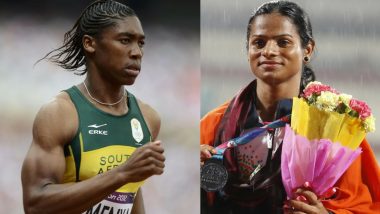As human beings, we vary greatly in our intellectual and physical makeup, depending upon our genetics, race and environmental factors. These variations end up giving us some kind of advantage over the others. To cite a few examples, a person born to artistic parents may have a better understanding of arts. This natural proclivity may help him get through UK’s Royal College of Arts with more ease than somebody else without that advantage. A high IQ may help you breeze through Joint Entrance Examinations, and if you are a voluptuous woman over 5.10”, your chances of walking the ramp for Victoria’s Secret are greater than your portly peers. But imagine having these genetic, cerebral or physical advantages held against someone to bar them from a competitive event. That’s probably the best way to describe an unfair policy that bars female from athletic events due to a certain physical advantage they have over the others.
The case on point is IAAF (International Association of Athletic Federations) and International Olympic Committee’s (IOC) sexist policy called the Hyperandrogenism Regulation updated in April 2011, which bars women who have high testosterone levels from competing with other females in the normal range, unless they are resistant to the testosterone. Two elite female athletes, Dutee Chand and Caster Semenya, have been at the receiving end of this draconian rule.
What is Hyperandrogenism?
Hyperandrogenism is a condition where the ovaries and adrenal glands in a woman’s body produce excessive levels of male hormone or androgens. Some of the common signs of hyperandrogenism in women are excessive hair growth on the body, acne, weight gain, menstrual irregularities and an elevated sex drive.
What causes Hyperandrogenism?
Medical causes of hyperandrogenism include polycystic ovary syndrome, idiopathic hirsutism, Cushing’s syndrome, hypothyroidism, hyperandrogenic insulin-resistant acanthosis nigricans (HAIRAN) syndrome, congenital adrenal hyperplasia, Androgen-secreting tumours and androgenic medication like danazol.
How does Hyperandrogenism Benefit Female Athletes?
Male hormones secreted by the testes and adrenal glands also play a role in promoting muscle strength in males, which gives them a physical advantage over women. Athletes are also known for taking androgens synthetically to improve muscle strength, size, aerobic endurance, decreased fat mass and faster recovery from physical exertion. According to an article in the British Medical Journal (BMJ), testosterone gives boost to red cell production, which increases the availability of oxygen in tissues and visuospatial abilities, important for throwing events and racket, team and acrobatic sports.
It also increases aggressiveness and mental drive in female athletes. So women who have more androgens will naturally have a competitive edge over women with less or normal levels of androgens. The BMJ article says that high testosterone levels result in competitive advantage in five events: 400-meter race, 400-meter hurdle, 800-meter race, hammer throw and pole vault.
How are the Rules of the Hyperandrogenism Regulation?
The IAAF has a three-stage process to detect hyperandrogenism in women athletes. Any sudden improvements in the athlete’s performance rouse suspicion of the IAAF. The women are then tested for testosterone levels. If it exceeds 10 nmol/L, they can be suspended or banned from the competition, unless they take measures to reduce their testosterone levels. Only if the women can prove that they derive no competitive benefit from their hyperandrogenism can they compete.The rationale behind the rule is to avoid instances of countries using men disguised as women to compete in the athletic events. The regulation is to ensure that the women participating in these events are in fact women.
Why is Hyperandrogenism Regulation Unfair?
The regulation is tamer in comparison to its earlier prototype, where female athletes were supposed to prove their ‘femaleness’ to compete. It started in the 1930s where female athletes were subjected to gynaecological exams, visual inspections, chromosome tests and genetic testing to verify their gender. These humiliating tests were then junked for being expensive, discriminatory and ineffective. In the end, most women were spared and only the ones who looked ‘suspicious’ were tested.
Firstly, having excessive androgens in the body gives the woman a natural advantage over others while competing for athletic events. It’s a gift rather than an unfair advantage. Barring female athletes on those grounds is akin to banning anyone above 6 feet from playing a basketball match. The competitors may have different physical capabilities and may vary in height, weight, lung function and stamina.
Secondly, the studies named five athletic events where the female athletes with high testosterone have an unfair advantage. But the regulation is applied only to the running and not to pole vault and hammer throw, where women are shown to have more advantage.
Thirdly, imposing measures to reduce testosterone in women (including surgically removing the clitoris) raises serious ethical questions. If performance enhancement is grounds for debarring an athlete, wouldn't performance reduction be wrong as well?
Lastly, the rule views gender in binaries: as either male or female. It doesn’t take into consideration athletes who fall under the intersex category or may conform to a different sexual identity. Female athletes decry the fact that femininity is forced upon them. Some observers also say that the regulation is nothing but a tool to systematically eliminate elite female athletes who are too fast or too successful and destroy their careers.
Dutee Chand who was barred from competing in the 2014 Commonwealth Games after she had more than normal levels of testosterone, had challenged the hyperandrogenism regulations. She had argued in front of the Court of Arbitration for her right to run and to compete without altering her physical capabilities. And in 2016, there was a glimmer of hope for her when the court ruled in favour of Chand, asking the IAAF to prove, one way or the other, how hyperandrogenism can give female athletes an advantage over the others.
(The above story first appeared on LatestLY on Apr 13, 2018 02:03 PM IST. For more news and updates on politics, world, sports, entertainment and lifestyle, log on to our website latestly.com).













 Quickly
Quickly


